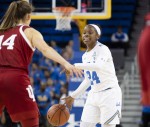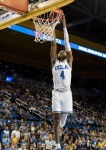Kennedy Burke hung her head at the sound of the final buzzer as the Bruins dropped their fourth consecutive game.
UCLA women’s basketball (3-5) fell to Indiana (7-0) 67-65 in the final seconds at home Sunday afternoon.
The senior guard had the opportunity to tie the game at 66 but a missed second free throw with five seconds remaining in the game allowed Indiana to seal the win. The Bruins are now facing their greatest losing streak since the 2014 season.
“I did my routine in my head,” Burke said. “I had a perfect follow through – I just feel like I pushed it a little too hard. Things like that happen.”
Burke went 6-for-15 from the field, scoring 15 points. Her eight rebounds on the game made her the fourth Bruin in program history with more than 1,000 points, 500 rebounds and 100 blocks.
Burke led the Bruins in a dominant first quarter. UCLA never trailed during the entirety of the first, nor for the first seven minutes of the second. But a layup by Indiana guard Bendu Yeaney propelled a 13-0 Hoosier run that extended into the second half.
Coach Cori Close said this marked the most important turning point in the game.
“I wouldn’t argue that (the game) came down to the last minute,” Close said. “It really came down to the seven minute run in the second quarter when we went up 10, to down seven.”
UCLA went 8-of-16 from the field in the first quarter, but only 4-of-17 in the second. The Hoosiers forced the Bruins into shooting from beyond the arc, but UCLA only shot 2-of-14 from the 3-point line throughout the first half.
“I don’t want our players playing scared,” Close said. “But where the disappointment came was where early in the shot clock we would settle for the 3-point shot. We should’ve probably settled for eight or nine (3-point shots) in that first half.”
A putback jumper by senior guard Japreece Dean put UCLA ahead again in the fourth. This was followed by five more lead changes of a two-point difference or less in the remainder of the contest.
After a layup by sophomore forward Michaela Onyenwere, the Bruins led 64-62 with 34 seconds left in the game. This shot gave Onyenwere a double-double, logging 13 points and 10 rebounds.
A 3-point shot, however, from Indiana guard Jaelynn Penn and assisted by guard Ali Patberg gave the Hoosiers a 65-64 lead with only 29 seconds remaining.
“(Patberg) just does an excellent job facilitating and getting (Indiana’s) players easier shots,” Close said. “That’s what we have to do. We have to let our teamwork create easier opportunities.”
Dean led UCLA in with three assists, while also putting up 16 points and going 7-for-18 from the field.
“It hurts to lose,” Dean said. “No one likes losing, and I know I hate it the most. So, we have to figure out a way to just grow over the next week and get ready for the next one.”
UCLA will next face Fresno State at home Friday. Close expects her team to improve and learn from this experience.
“I am relentlessly believing in this team, and I am relentlessly holding the standard in what I think they can become,” Close said. “I can guarantee you that we will continue to get better and fight like crazy.”






